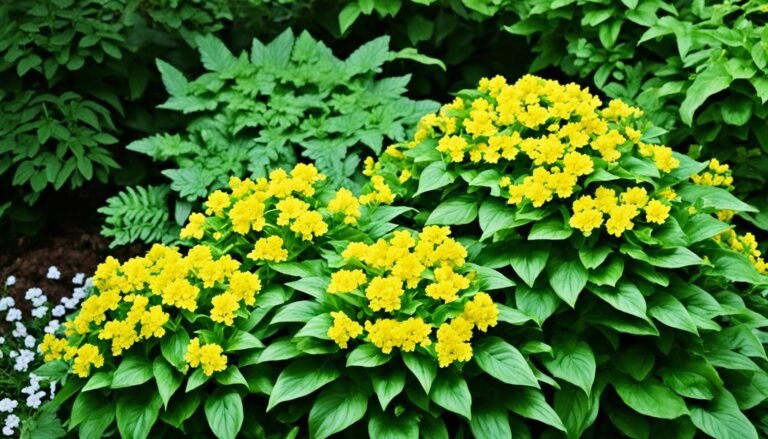Shade gardens can sometimes feel dull, with their cool, muted tones. But what if I told you there’s a way to add a pop of vibrant color to those low-light areas? Enter yellow-flowered shade plants! These beautiful blooms not only brighten up your garden but also thrive under the canopy of trees and in shaded corners of your yard.
Imagine walking into your shaded garden area and being greeted by a burst of sunshine yellow. The sight of these yellow-flowered shade plants can instantly lift your mood and create a welcoming atmosphere. Picture strolling along a winding path, surrounded by delicate yellow petals swaying in the gentle breeze. It’s like walking through a field of sunshine, even in the shadiest spots.
But what types of plants are we talking about here? Think of the delicate and charming yellow dwarf iris, the unique and cheerful yellow parrot tulips, or the fall beauty of goldenrod. These shade-loving beauties are just a glimpse of what awaits you in the world of yellow-flowered shade plants.
So, whether you have a shaded patio, a woodland area, or even a corner of your yard that doesn’t get much sunlight, don’t despair. With the right selection of yellow-flowered shade plants, you can transform those shaded areas into vibrant, eye-catching spaces that will leave your neighbors green with envy.
Ready to brighten up your shade garden? Let’s explore some of the best shade loving plants with yellow flowers that will bring life to your low-light garden areas.
Key Takeaways:
- Shade gardens can feel dull, but yellow-flowered shade plants add a pop of vibrant color.
- These plants thrive in low-light and shaded areas and bring life to your landscape.
- Yellow dwarf iris, yellow parrot tulips, goldenrod, and more are excellent choices for your shade garden.
- Transform your shaded areas into vibrant, eye-catching spaces with the right selection of yellow-flowered shade plants.
- Get ready to brighten up your shade garden and create a visually stunning landscape.
Top 7 Shade Loving Plants with Yellow Flowers
Are you looking to add a vibrant touch to the shaded areas of your garden? Look no further! In this section, I will introduce you to seven stunning shade loving plants with yellow flowers that are perfect for low-light and shaded areas. These plants not only thrive in partial shade or full shade conditions but also bring a burst of color to your landscape.
Let’s take a closer look at these shade plants for low light that will brighten up your shaded areas:
-
Yellow Dwarf Iris
A charming woodland perennial, the Yellow Dwarf Iris (Iris danfordiae) features petite golden-yellow flowers that add a touch of elegance to any garden. This shade-loving plant adapts well to partial shade, making it an ideal choice for naturalizing and illuminating woodland settings. It reaches a height of about 6 inches and prefers well-drained soil.
-
Yellow Parrot Tulips
Add a unique and cheerful touch to your garden with Yellow Parrot Tulips (Tulipa × gesneriana Parrot Group). These tulips boast full, ruffled petals with intricate fringed edges, creating visually captivating blooms. Growing to a height of 16-18 inches, these shade plants with bright yellow blooms prefer full sun to light shade and well-drained soil.
-
Goldenrod
Incorporating Goldenrod (Solidago) into your shaded areas brings a beautiful fall display to your garden. This native perennial plant showcases clusters of mustard yellow flowers arranged in plume-like structures on each stem. Standing tall at heights ranging from 1 to 6 feet, Goldenrod thrives in full sun and well-drained soil.
-
Yellow Canna Lilies
For a touch of tropical elegance in partially shaded areas, Yellow Canna Lilies (Cannaceae family) are an excellent choice. These large-frilled flowers in a radiant yellow color beautifully contrast with their deep green foliage. With a blooming season from mid-summer to frost, these canna lilies thrive in part shade and organically rich, well-drained soil, reaching heights of 30 to 48 inches.
-
Daffodils
Bring early spring color to your shaded areas with Daffodils (Narcissus), a well-known perennial that is also low maintenance. These bright yellow flowers not only add beauty to your garden but also multiply on their own, creating naturalized clusters. Daffodils prefer full to part sun and well-drained soil, ranging in height from 6 to 24 inches.
-
Tickseed
Tickseed (Coreopsis), a native perennial plant, offers delicate beauty with its long-lasting, bright daisy-like blooms. The golden yellow flowers create a glorious display in early summer, attracting numerous butterflies. Tickseed’s fern-like foliage adds unique texture to the garden. It prefers full to part sun and sandy or rocky, well-drained soil, growing to heights ranging from 12 to 24 inches.
-
Native Perennial Sunflowers
For late-season showy blooms in full sun, consider Native Perennial Sunflowers (Helianthus genus). These sunflowers resemble smaller versions of the classic annual sunflower but return year after year. Their bright yellow or orange petals surrounding a central disc are not only spectacular but also attract butterflies. Reaching heights of 3 to 8 feet, these native perennials thrive in full sun and fertile, well-drained soil.
By incorporating these shade loving plants with yellow flowers into your garden, you can transform your shaded areas into vibrant and visually appealing spaces. Whether you have partial shade or full shade conditions, these plants will thrive and bring life to your landscape.
Yellow Dwarf Iris: A Charmingly Petite Shade Lover
When it comes to shade loving plants with yellow flowers, the yellow dwarf iris (Iris danfordiae) is a delightful choice. This woodland perennial features petite golden-yellow flowers that add a touch of brightness to any shaded area of your garden.
This shade-loving plant is highly adaptable to partial shade conditions, making it a perfect fit for gardens with dappled sunlight or areas under trees. Its petite size, growing to about 6 inches tall, makes it an excellent candidate for naturalizing in woodland settings.
The yellow dwarf iris prefers well-drained soil, thriving in moisture-retaining yet breathable conditions. Planting them in a mixture of organic matter and loamy soil will encourage healthy growth and vibrant blooms.
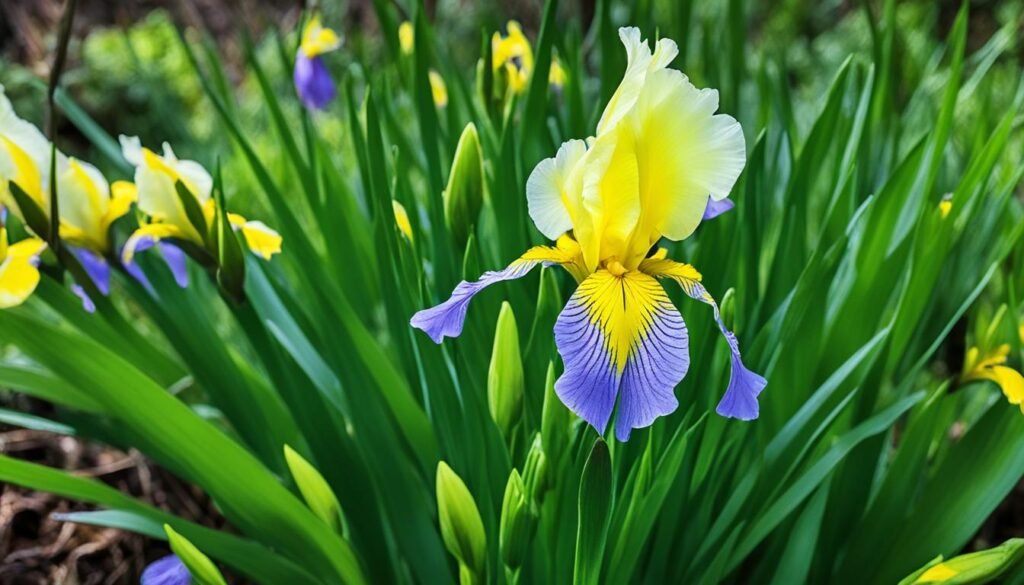
Yellow Dwarf Iris Care Tips
- Plant yellow dwarf iris bulbs in the early fall, about 3 to 4 inches deep and 3 to 4 inches apart.
- Water the bulbs after planting to ensure proper establishment.
- Provide a layer of mulch around the plants to help retain moisture and regulate soil temperature.
- Regularly check the soil moisture levels and water as needed to keep the soil slightly moist, but not waterlogged.
- Remove any dead or faded flowers to maintain a neat appearance and encourage prolonged blooming.
- Divide the bulbs every 3 to 4 years in early fall to prevent overcrowding and promote healthier growth.
Yellow dwarf iris adds a charming touch to shaded gardens, with its petite stature and vibrant yellow flowers. The delicate blooms bring a sense of brightness and cheerfulness to even the darkest corners of your garden.
With its adaptability, yellow dwarf iris is a versatile choice for woodland gardens, rockeries, or even containers. Its alluring golden-yellow flowers are sure to captivate your attention and bring life to any shaded area.
Yellow Parrot Tulips: Unique and Cheerful Blooms
Yellow parrot tulips, scientifically known as Tulipa × gesneriana Parrot Group, are a unique variety of tulips with full, ruffled petals and intricate fringed edges. No two flowers are exactly alike, making them visually interesting in the garden. The sunny and cheerful color of these tulips symbolizes happiness and positivity. They grow to about 16-18 inches tall and prefer full sun to light shade with moist, well-drained soil.
| Tulip Variety | Height | Exposure | Soil |
|---|---|---|---|
| Yellow Parrot Tulips | 16-18 inches | Full sun to light shade | Moist, well-drained |
Goldenrod: A Fall Beauty for Shaded Areas
When it comes to adding a burst of warm color to your garden in the fall, goldenrod is a standout choice. Also known as Solidago, goldenrod is a native perennial plant that thrives in shaded areas, making it a perfect addition to low light gardens. Its clusters of mustard yellow flowers create plume-like structures at the top of each stem, adding a touch of elegance to your landscape.
But goldenrod offers more than just aesthetic appeal. As a keystone plant, goldenrod plays a vital role in supporting various species of wildlife, including birds, butterflies, moths, and bees. It serves as a valuable food source and habitat for these creatures, making it an excellent choice for creating a biodiverse and ecologically friendly garden.
In terms of growth, goldenrod can reach heights ranging from 1 to 6 feet, making it a versatile plant that can be incorporated into different areas of your garden. It prefers full sun and well-drained soil, so be sure to find a suitable spot that meets these requirements for optimum growth and vibrancy.
If you’re interested in introducing goldenrod to your garden, here’s a snapshot of its key characteristics:
| Common Name | Scientific Name | Height | Sunlight | Soil |
|---|---|---|---|---|
| Goldenrod | Solidago | 1 to 6 feet | Full sun | Well-drained |
Table 5: Key Characteristics of Goldenrod
With its striking yellow blooms and ability to thrive in shaded areas, goldenrod is a wonderful choice for adding a touch of autumnal beauty to your garden. Consider incorporating this native plant into your landscape and enjoy the vibrant colors it brings, along with the benefits it provides to wildlife.
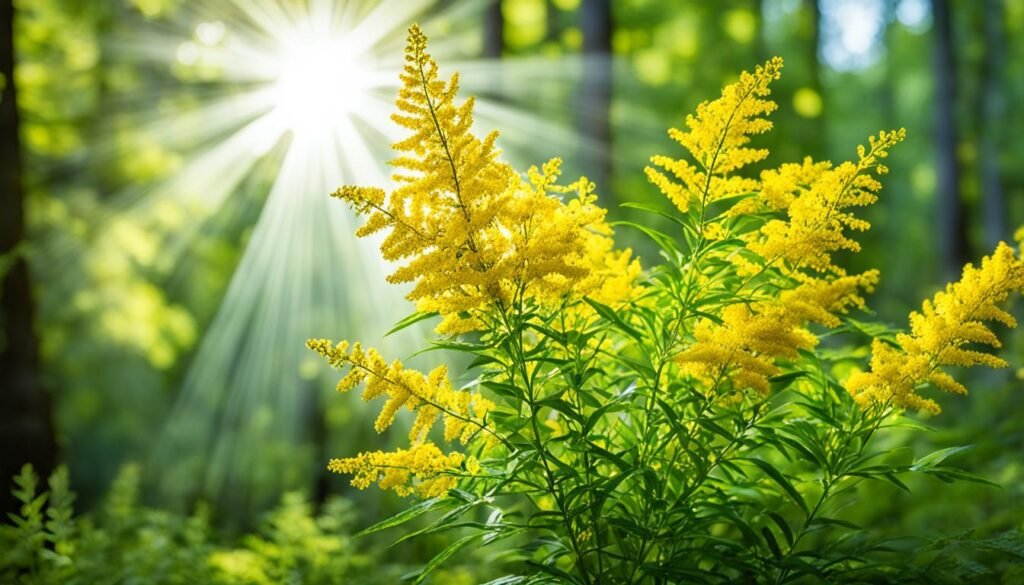
Yellow Canna Lilies: Tropical Elegance for Partial Shade
Yellow canna lilies, part of the Cannaceae family, are not true lilies but offer a tropical feel to any garden. They have large, frilly flowers in a clear, illuminating yellow color that stands out against the deep green foliage. These canna lilies bloom from mid-summer to frost and prefer part shade with organically rich, well-drained soil. They can reach heights of 30 to 48 inches.
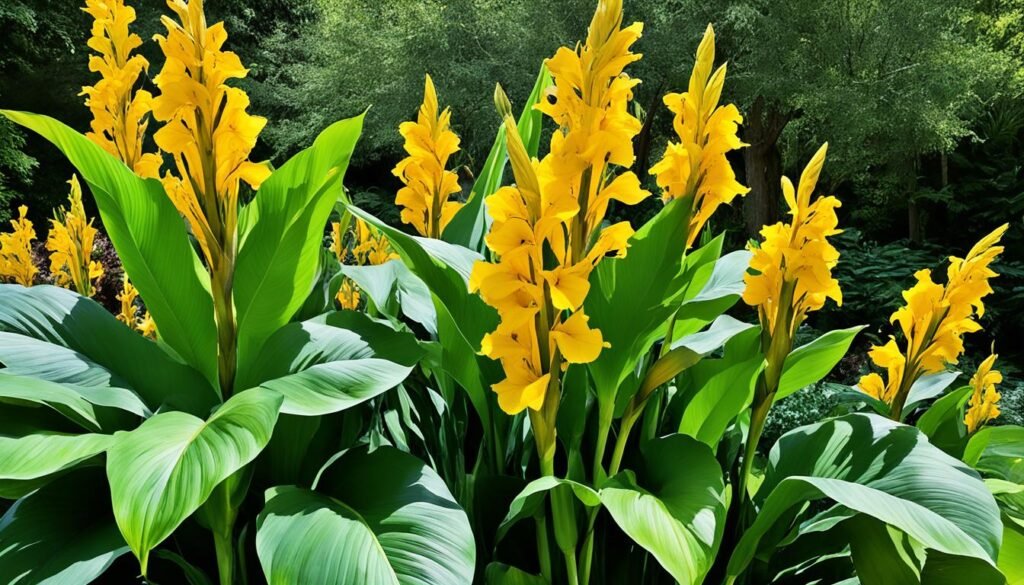
Adding yellow canna lilies to your partial shade garden can bring an elegant and tropical touch. The vibrant yellow flowers create a stunning contrast against the lush green leaves, making them a focal point in any landscape. These tropical perennials thrive in areas with low light, making them perfect for shaded gardens.
Benefits of Yellow Canna Lilies for Partial Shade
- Provides a tropical vibe to your garden
- Large, frilly yellow flowers add a splash of color
- Thrives in low light conditions
- Creates an eye-catching focal point
- Can reach impressive heights, adding vertical interest
- Easy to grow and maintain
Whether you want to enhance an existing shade garden or create a striking display in a partially shaded area, yellow canna lilies are an excellent choice. Their vibrant blooms and tropical allure will elevate your landscape and bring a touch of elegance to your outdoor space.
Care Tips for Yellow Canna Lilies
To ensure the healthy growth and prolonged blooming of your yellow canna lilies, follow these care tips:
- Plant in well-drained soil enriched with organic matter.
- Provide partial shade to protect the plants from intense sunlight.
- Water regularly, keeping the soil evenly moist.
- Apply a balanced fertilizer during the growing season to promote vigorous flowering.
- Remove faded flowers to encourage continuous blooming.
- Divide overcrowded clumps every few years to maintain plant health and vigor.
By following these care guidelines, you can enjoy the beauty of yellow canna lilies and their tropical elegance in your garden year after year.
Comparison of Yellow Canna Lilies
| Variety | Height | Bloom Time | Light Requirements |
|---|---|---|---|
| Yellow King Humbert | 30-36 inches | Mid-summer to frost | Partial shade |
| Yellow Futurity | 36-48 inches | Mid-summer to frost | Partial shade |
| Yellow King | 36-42 inches | Mid-summer to frost | Partial shade |
Table: Comparison of yellow canna lily varieties
Please note that the heights mentioned are approximate and may vary depending on growing conditions.
Daffodils: Early Spring Color for Shaded Areas
Daffodils, scientifically known as Narcissus, are well-known perennials that provide bright, cheerful, and early spring color to shaded areas. Their large, yellow flowers are not only beautiful, but they also naturalize and multiply on their own, making them low maintenance flowers.
Daffodils prefer full to part sun and well-drained soil. They can range in height from 6 to 24 inches, depending on the variety.
These vibrant flowers are a symbol of hope and renewal and are often associated with spring and Easter. Their arrival signals the end of winter and the beginning of warmer days. Daffodils are a popular choice in gardens, parks, and flower beds, adding a burst of color to any shaded area.
Whether planted beneath trees, along walkways, or in mixed flower borders, daffodils thrive in shady conditions and bring a touch of sunshine to areas where other plants may struggle to grow.
| Daffodils: Early Spring Color for Shaded Areas | Top 3 Benefits |
|---|---|
| 1. Brightens shaded areas | – Adds vibrant, cheerful color to low-light gardens – Provides an early burst of color in spring – Naturalizes and multiplies on its own, requiring minimal maintenance |
| 2. Versatile and adaptable | – Thrives in both full and partial shade – Can be grown in various soil types, as long as it is well-drained – Suitable for different garden styles, including formal and naturalistic |
| 3. Wildlife-friendly | – Attracts pollinators, such as bees and butterflies – Provides a food source for early-emerging insects – Serves as a natural indicator of spring for wildlife |
Choosing the Right Daffodil Varieties for Shaded Areas
When selecting daffodil varieties for shaded areas, it is important to choose those with a high tolerance for low light conditions. Some recommended varieties include:
- Daffodil Variety 1
- Daffodil Variety 2
- Daffodil Variety 3
These varieties have been specifically bred or selected to thrive in shady conditions, ensuring that you will enjoy their vibrant blooms even in areas with limited sunlight.
Quote: “Daffodils bring a ray of sunshine to shady corners, brightening up our gardens and lifting our spirits after a long winter.” – Gardening Expert

Tips for Growing Daffodils in Shaded Areas
Here are some tips to ensure successful growth and blooming of daffodils in shaded areas:
- Plant daffodil bulbs in the fall, ideally around 4-6 weeks before the ground freezes.
- Choose a well-drained location that receives at least a few hours of direct sunlight each day.
- Prepare the soil by adding organic matter, such as compost, to improve drainage and fertility.
- Plant the bulbs pointed end up, at a depth of approximately 2-3 times their height.
- Space the bulbs according to the specific variety’s recommendations.
- Water the bulbs after planting and keep the soil evenly moist throughout the growing season.
- Apply a slow-release fertilizer formulated for bulbs in early spring to promote healthy growth.
- Deadhead spent blooms to redirect energy back into the bulb for future growth.
- Allow the foliage to naturally wither and turn yellow before removing it, as this helps replenish the bulb for the following year.
By following these tips and selecting shade-tolerant daffodil varieties, you can enjoy a burst of vibrant yellow blooms in your shaded garden areas, bringing early spring color and beauty to your outdoor space.
Tickseed: Delicate Beauty for Full to Part Sun
Tickseed, also known as Coreopsis, is a native perennial plant that adds a delicate beauty to your garden. With its long-lasting, bright daisy-like blooms, tickseed creates a glorious early summer display that is sure to catch the eye. Not only do these golden yellow flowers bring a vibrant pop of color, but they also attract numerous butterflies, adding charm and life to your outdoor space.
The foliage of tickseed is typically delicate and fern-like, which adds a unique texture to your garden. The combination of the colorful blooms and delicate foliage creates a visually stunning display that is sure to delight any observer.
Tickseed thrives in full to part sun, making it an excellent choice for both sun-drenched areas and those with partial shade. It prefers sandy or rocky well-drained soil, which mimics its natural habitat. With proper care and growing conditions, tickseed can reach heights ranging from 12 to 24 inches, creating a beautiful backdrop or border in your garden.

Tickseed Planting and Care Tips
If you’re considering adding tickseed to your garden, here are some planting and care tips to help you get started:
- Choose a sunny spot in your garden or a location that receives partial shade.
- Ensure the soil is well-drained, sandy, or rocky.
- Water regularly, especially during dry spells, but avoid overwatering.
- Divide larger clumps of tickseed every two to three years to maintain their vigor.
- Remove spent blooms to encourage continuous flowering.
- Consider planting tickseed alongside other native perennials for a natural and diverse garden.
Tickseed Varieties
Tickseed comes in various cultivars, each with its own unique characteristics. Here are a few popular tickseed varieties to consider:
| Variety | Height | Bloom Color |
|---|---|---|
| Coreopsis grandiflora ‘Sunfire’ | 18-24 inches | Bright yellow |
| Coreopsis verticillata ‘Moonbeam’ | 12-18 inches | Pale yellow |
| Coreopsis ‘Zagreb’ | 12-18 inches | Golden yellow |
“Tickseed’s delicate blooms and fern-like foliage bring a touch of elegance to any garden. Its vibrant yellow flowers and easy-care nature make it a popular choice for both novice and experienced gardeners.” – Garden Enthusiast Magazine
With its delicate beauty, tickseed is an excellent choice for adding color, texture, and charm to your garden. Whether you have full sun or partial shade, this native perennial will thrive and bring joy to your outdoor space. Consider incorporating tickseed into your landscape and watch as its bright blooms and graceful foliage create a stunning visual display.
Native Perennial Sunflowers: Late Season Blooms for Full Sun
If you’re looking to add a burst of color to your garden late in the season, look no further than native perennial sunflowers. These stunning flowers, belonging to the Helianthus genus, are known for their showy blooms that bloom well into the fall, making them a perfect choice for gardens that need a touch of brightness before winter sets in.
Native perennial sunflowers are reminiscent of their popular annual counterparts but with a twist. Unlike their annual siblings, these sunflowers come back year after year, bringing joy and beauty to your garden without the need for replanting. Their vibrant yellow or orange petals encircle a central disc, creating a striking contrast that is sure to catch the eye. Additionally, their vibrant colors attract butterflies and other pollinators, making them a valuable addition to any garden that seeks to support local wildlife.
When it comes to planting native perennial sunflowers, it’s important to consider their preferred growing conditions. These sunflowers thrive in full sun, so make sure to choose a location in your garden that receives at least six hours of direct sunlight per day. Additionally, they prefer fertile, well-drained soil that allows their roots to spread and find their way deep into the ground. By providing them with the right conditions, you’ll be rewarded with sunflowers that can grow to impressive heights, ranging from 3 to 8 feet.
To showcase the beauty and variety of native perennial sunflowers, the table below highlights some popular species along with key characteristics:
| Native Perennial Sunflower Varieties | Height | Bloom Time | Preferred Soil |
|---|---|---|---|
| Helianthus giganteus | 6-12 feet | Late summer to fall | Moist to wet soil |
| Helianthus maximiliani | 4-10 feet | Late summer to fall | Dry to medium soil |
| Helianthus angustifolius | 3-7 feet | Mid-summer to fall | Moist to wet soil |
With their late-season showy blooms, native perennial sunflowers can bring a vibrant touch to your garden when many other flowers have already faded away. Whether you plant them as a focal point or incorporate them into a mixed flower bed, their bright colors and attractive form are sure to make a statement. Don’t miss the opportunity to include these beautiful flowers in your garden and create a late-season spectacle that will have everyone admiring your green thumb.

Black-Eyed Susans: Contrast and Vibrancy in Full Sun
Black-eyed Susans, scientifically known as Rudbeckia, are a popular choice for gardeners seeking contrast and vibrancy in full sun areas. These stunning flowers are characterized by their bright yellow petals and striking black centers, creating a captivating visual display in any garden. Black-eyed Susans can be grown as perennials, biennials, or annuals, depending on the variety, making them a versatile option for different gardening preferences.
One of the standout features of Black-eyed Susans is their ability to self-seed easily. This means that once planted, they will often return year after year, filling your garden with vibrant blooms without the need for constant replanting. This makes Black-eyed Susans not only visually appealing but also a low-maintenance choice for busy gardeners.
These shade plants for low light prefer full sun conditions to thrive. Placing them in an area that receives at least six hours of direct sunlight per day will ensure optimal growth and blooming. Black-eyed Susans also prefer moist, organically rich soil, so it’s important to provide regular watering and amend the soil with compost or other organic matter to ensure their success.
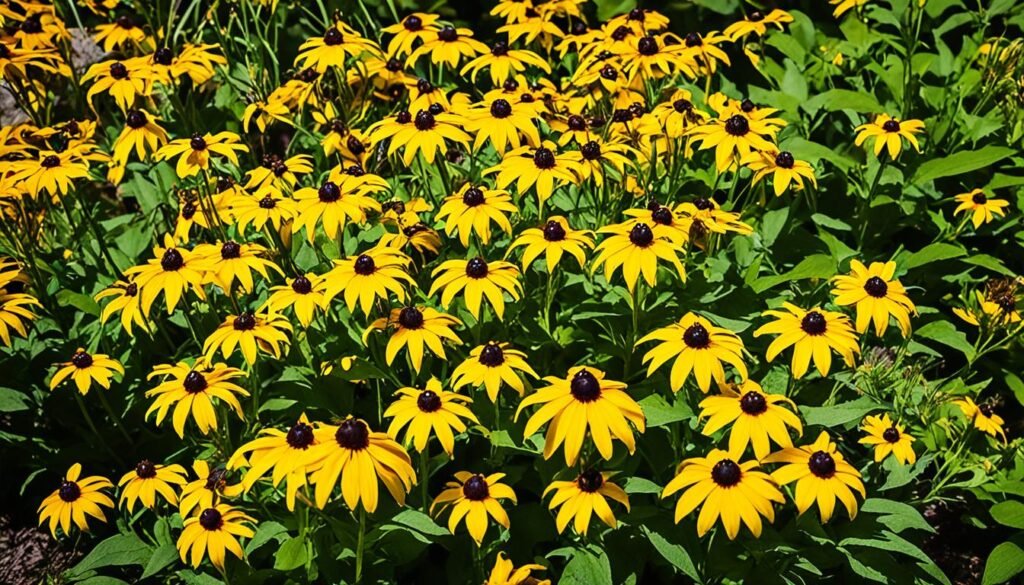
Benefits of Black-Eyed Susans
Black-eyed Susans offer a range of benefits for your garden beyond their aesthetic appeal. Here are some notable advantages of including Black-eyed Susans in your landscape:
- Attracts pollinators: The vibrant blooms of Black-eyed Susans act as a magnet for various pollinators, including bees and butterflies, helping to support the overall health and biodiversity of your garden.
- Drought tolerant: Once established, Black-eyed Susans have good drought tolerance, making them suitable for areas with limited water availability. This trait makes them an excellent choice for gardeners looking for low-maintenance plants that can withstand dry spells.
- Long blooming period: Black-eyed Susans have an extended blooming period that typically begins in midsummer and continues into the fall. This provides continuous color and visual interest in your garden throughout the warmer months.
- Companion planting: Black-eyed Susans can be paired with a variety of other plants to create visually appealing combinations. They work well with ornamental grasses, coneflowers, and other native perennials, allowing you to design a stunning garden display.
Black-Eyed Susans Care Guide
| Aspect | Requirements |
|---|---|
| Light | Full sun (at least 6 hours of direct sunlight) |
| Soil | Moist, organically rich |
| Watering | Regular, to keep soil evenly moist |
| Height | 2 to 3 feet |
| Blooming period | Midsummer to fall |
| Maintenance | Low |
Overall, Black-eyed Susans are a fantastic addition to any garden, offering a burst of vibrant color, contrast, and self-seeding capabilities. With their easy-care nature and attractive blooms, they are a popular choice among gardeners looking to brighten up their full sun areas.
Conclusion
Incorporating shade loving plants with yellow flowers into your garden can brighten up low-light areas and add a splash of vibrant color. Whether you have partial shade or full shade conditions, there is a shade plant with bright yellow blooms that will thrive in your garden. From woodland perennials like the yellow dwarf iris to showy flowers like the yellow parrot tulips, you have numerous options to choose from.
Experiment with different varieties and create a visually stunning landscape that will bring life to your shaded areas. With their ability to tolerate and even thrive in low-light conditions, shade loving plants with yellow flowers are the perfect additions to your shade garden. They not only provide a stunning display of color but also bring joy and happiness to your outdoor space.
Whether you prefer the delicate beauty of tickseed or the bold tropical elegance of yellow canna lilies, these shade garden plants will transform your shaded areas into vibrant and lively spaces. So, don’t let the shade discourage you from creating a beautiful garden. Embrace the opportunities that shade offers and let these yellow flowering shade plants bring brightness and charm to your outdoor oasis.
